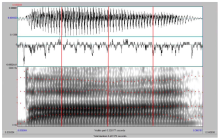/aɪ/ monophthongization as a marker of Southern speech has been an object of linguistic study for decades (Evans 1935, Johnson 1928, Wise 1933). Recent studies by Fridland (2003), Thomas (2001), and Labov, Ash, and Boberg (2006) have begun to investigate the correlations between /aɪ/ monophthongization and the social features of ethnicity, age, gender, and city size. The following thesis takes up the study of /aɪ/ monophthongization in the city of Deer Park, Texas, a suburb located 20 miles southeast of Houston.
There are two main goals to this study. The first goal is to test the effect of linguistic variables, task variables, and social variables on /aɪ/ monophthongization in Deer Park, Texas, and to compare the findings for these variables to existing research. The second goal of this study is to carry out and compare three different methods for measuring monophthongization. For this study, three measurements have been calculated for each vowel: ΔF1, change in vowel height over time; ΔF2, change in vowel backness over time; and offset F2-F1, the difference between the first and second formants at the vowel offset.
The statistical results indicate that voicing of the following consonant, open versus closed syllable, word list versus map task, map task versus interview, gender, and youngest versus middle age group all have a significant effect on /aɪ/ monophthongization whether it is measured by ΔF1, ΔF2, or offset F2-F1. The difference between the middle and oldest age group is only statistically significant for ΔF1, which suggests that ΔF1 may be a particularly important cue for distinguishing between middle and oldest age group speakers.
